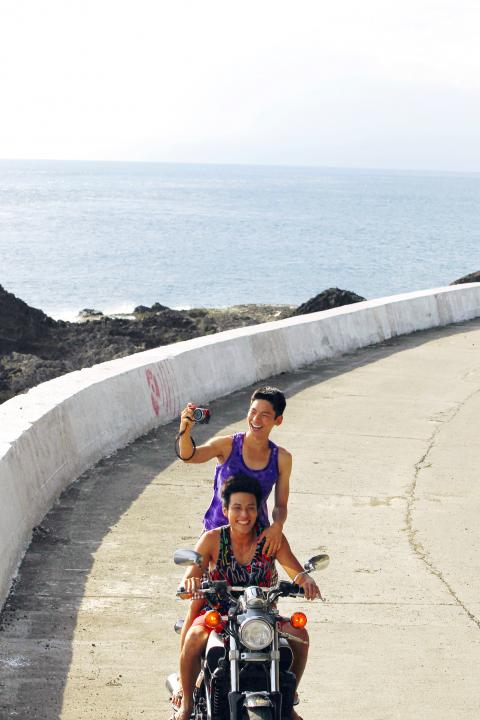Billed as a travelogue across Taiwan, Leading Lee’s (李鼎) second feature, Anywhere, Somewhere, Nowhere (到不了的地方), is, in reality, a personal search for one’s roots and identity.
The largely autobiographical account of the director’s cross-country trip with real-life swimming coach Hsu Chun-hao (徐君豪) adheres to the framework of a road movie, in which the hero struggles to tackle loss through self-discovery. The film’s uncertain attempt to address the theme of gay love suggests, however, a less-than-honest attempt to create what seems to be the cinematic confession of a troubled son.
Based on a travel book written by Lee and Hsu of a six-month journey in 2004, the film follows commercial director Lee Ming (Austin Lin, 林柏宏) and swimming coach Taike (Bryant Chang, 張睿家) as the two ride across the island on a motorbike. Having just lost his army officer father (Tou Tsung-hua, 庹宗華), who died due to a neurological disorder, Lee Ming longs to revisit a restaurant where they ate during a childhood trip to Taroko Gorge (太魯閣). Taike, on the other hand, is a runaway groom who dreams of swimming with flying fish on Lanyu Island (蘭嶼).

Photo Courtesy of Applause Entertainment
When they arrive at Taroko Gorge, however, the restaurant has closed. Disappointed, they continue their journey south to Jioumei (久美), where they learn about the Thousand Year Suspension Bridge (千歲吊橋), a story about a Japanese officer and an Aboriginal princess who jumped to their deaths nearly a century ago because their love was prohibited.
They then travel to Lanyu and make friends with the island’s residents, who hail from the Tao (達悟) tribe, and newcomers from Taiwan’s mainland. Throughout the journey, Lee Ming keeps returning to the same question: where is home?
Unevenly executed and, at times, messy, the film nevertheless clings to its motif of home, ingeniously connecting the protagonist’s search for the lost father with his rediscovery of the land. A son of a soldier forced to flee to Taiwan with the Chinese Nationalist Party (KMT) army, the character of Lee Ming travels to remote towns, villages and indigenous tribes to seek traces of the deceased and, during the process, is able to gain insights and strength to reconcile with his family.
The often overwrought dialogue and flowery language that made Lee’s debut feature My So Called Love (愛的發聲練習) disastrous, strangely fit the tone of the autobiographic work, as they are more like reflections of the protagonist’s inner soliloquies and deliriums as he struggles to deal with his great loss.
Fantasy and dream sequences often reveal hidden emotions. The sequence that involves the love between the indigenous princess and her Japanese lover, for example, not only touches upon the country’s colonial past but mirrors the implicitly felt because never admitted attraction between the two travel buddies. There is an undercurrent of homoeroticism throughout the film, in which Chang’s character can always find excuses to take his shirt off and display his well-toned body.
While gay identity marks the narrative, Leading Lee’s dubious reluctance to go further than showing harmless banter between the two men leaves the story partly underdeveloped and plots unexplained. In the end, Anywhere, Somewhere, Nowhere feels unfinished, missing its chance to become an admirably honest work.

May 11 to May 18 The original Taichung Railway Station was long thought to have been completely razed. Opening on May 15, 1905, the one-story wooden structure soon outgrew its purpose and was replaced in 1917 by a grandiose, Western-style station. During construction on the third-generation station in 2017, workers discovered the service pit for the original station’s locomotive depot. A year later, a small wooden building on site was determined by historians to be the first stationmaster’s office, built around 1908. With these findings, the Taichung Railway Station Cultural Park now boasts that it has

Wooden houses wedged between concrete, crumbling brick facades with roofs gaping to the sky, and tiled art deco buildings down narrow alleyways: Taichung Central District’s (中區) aging architecture reveals both the allure and reality of the old downtown. From Indigenous settlement to capital under Qing Dynasty rule through to Japanese colonization, Taichung’s Central District holds a long and layered history. The bygone beauty of its streets once earned it the nickname “Little Kyoto.” Since the late eighties, however, the shifting of economic and government centers westward signaled a gradual decline in the area’s evolving fortunes. With the regeneration of the once

In February of this year the Taipei Times reported on the visit of Lienchiang County Commissioner Wang Chung-ming (王忠銘) of the Chinese Nationalist Party (KMT) and a delegation to a lantern festival in Fuzhou’s Mawei District in Fujian Province. “Today, Mawei and Matsu jointly marked the lantern festival,” Wang was quoted as saying, adding that both sides “being of one people,” is a cause for joy. Wang was passing around a common claim of officials of the People’s Republic of China (PRC) and the PRC’s allies and supporters in Taiwan — KMT and the Taiwan People’s Party — and elsewhere: Taiwan and

Even by the standards of Ukraine’s International Legion, which comprises volunteers from over 55 countries, Han has an unusual backstory. Born in Taichung, he grew up in Costa Rica — then one of Taiwan’s diplomatic allies — where a relative worked for the embassy. After attending an American international high school in San Jose, Costa Rica’s capital, Han — who prefers to use only his given name for OPSEC (operations security) reasons — moved to the US in his teens. He attended Penn State University before returning to Taiwan to work in the semiconductor industry in Kaohsiung, where he